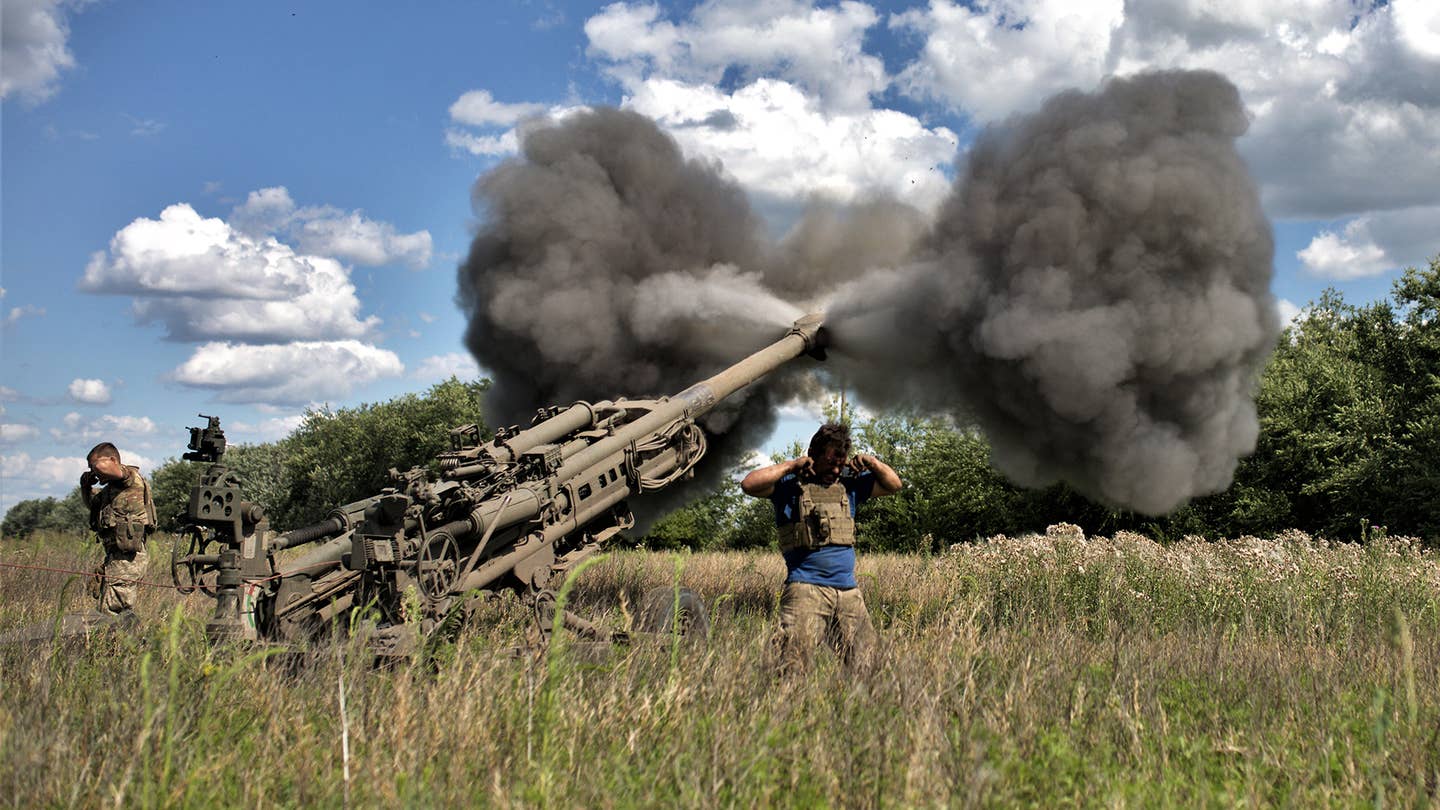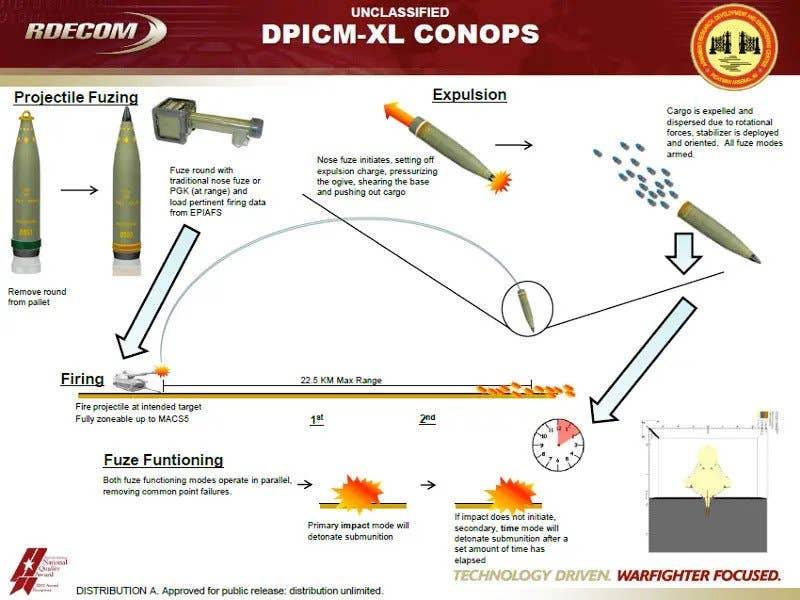HOWARD ALTMAN

Ukraine is now using cluster munitions on the battlefield “quite effectively,” and they already having an affect on Russian forces, the White House confirmed Thursday.
"We have gotten some initial feedback from the Ukrainians, and they're using them quite effectively," White House National Security Council spokesman John Kirby said at a news briefing Thursday. He added the cluster munitions are having an impact on Russian defensive formations and maneuvering, Reuters reported. At the Pentagon, Deputy Press Secretary Sabrina Singh also confirmed Ukraine is now using the cluster munitions.
The Pentagon two weeks ago announced it was sending Ukraine “hundreds of thousands” of rounds of controversial cluster munitions known as Dual-Purpose Improved Conventional Munitions (DPICMs). They are 155mm artillery munitions that contain individual submunitions, or bomblets.
The DPICMs are being provided for two main reasons, the Pentagon has previously explained. The U.S. has a large stock of them and giving some to Ukraine won’t have the same effect on supplies as the donation 155mm unitary rounds. The U.S. alone has donated more than two million of those to Ukraine.
The other main reason is that bomblets scatter over a wide area, which would help Ukraine defeat the massive amount of fortifications and trenches Russia has built up, in addition to hitting counter-battery and time-sensitive targets more efficiently.
 A US Army briefing slide discussing the functioning of a more modern DPICM-XL projectile. US Army
A US Army briefing slide discussing the functioning of a more modern DPICM-XL projectile. US ArmyYou can read more about these munitions, what they can do, why they are controversial and Ukraine's efforts to mitigate the dangers in our story here.
Russian Telegram channels have taken note of the first uses of DPICMs cluster munitions, which they refer to as "cassettes."
"The enemy began to massively use cluster munitions on the Zaporizhzhia and [Bakhmut] fronts," said the Operation Z Telegram channel. "The footage shows the shelling of our positions with "cassettes" in the Zaporizhzhia direction. There is also evidence that the enemy is actively using them on the flanks near [Bakhmut] and on the South-Donetsk sector of the front. The soldiers report that the enemy has used them before, but in smaller numbers."
"Heavy [multiple launch rocket system] MLRS strikes and the use of cluster munitions by the enemy are seen...as a way to overcome the tactical defense of the [Russian] Armed Forces," the Colonelcassad Telegram channel wrote. "The situation requires an increase in the use of cluster munitions by our troops. They will be very effective in hitting [areas] through which the enemy is trying to advance infantry assault groups."
One well-known Russian milblogger, Mikhail Luchin - known as "Misha in Donbas" - was reportedly killed today during a cluster munitions strike, the War Gonzo Telegram channel reported.
In April, we told you how Luchin was hacked by Ukrainians, who say they charged $25,000 worth of adult toys to his credit card. The hackers claimed the Luchin was going to use the money to buy drones for Russian troops.
While Russians may complain about DPICMs, it should noted that they have been using much more dangerous cluster munitions indiscriminately throughout their so-called 'special military operation.'
This first use of DPICMs by Ukraine is only the beginning. How effective they are as the counteroffensive grinds slowly on, remains to be seen.
We will provide additional details when they become available.
Before we head into the latest from Ukraine, The War Zone readers can catch up on our previous rolling coverage here.
On the battlefield, Ukraine continued to make incremental gains in its counteroffensive that is pushing through Zaporizhzhia and the Donbas. Here are some key takeaways from the latest Institute for the Study of War assessment:
Ukrainian forces conducted counteroffensive operations on at least three sectors of the front on July 19 and made gains in these areas.
Ukrainian forces continued offensive operations in the Kupyansk area, near Kreminna, in the Bakhmut area, and along the Avdiivka-Donetsk City front and made gains near Bakhmut.
Russian forces continued offensive operations along the Kupyansk-Svatove-Kreminna line, in the Bakhmut area, along the Avdiivka-Donetsk City front, and in the western Donetsk-eastern Zaporizhia oblast area. They made marginal gains along the Avdiivka-Donetsk City front and reportedly made limited advances in the western Donetsk-eastern Zaporizhia oblast area.
Ukrainian forces continued counteroffensive operations in the western Donetsk-eastern Zaporizhia area and western Zaporizhia Oblast and made reportedly made gains in both sectors of the front.
Just days after the Kerch Bridge was attacked, reportedly by Ukrainian uncrewed surface vessels, air raid sirens have gone off several times there today. It's unclear why the alarms sounded, but given that the bridge has been struck twice now since October, you can understand why folks in that part of Crimea would be nervous. The bridge, a key logistics crossing for Russia's military, has long been a stated target of Ukraine.
With tens of billions of dollars of military and humanitarian assistance pouring in from foreign donors, Ukraine has agreed to work with NATO on the launch of a Procurement Review program, Ukrainian Defense Minister Oleksii Reznikov said during a press conference Thursday.
That decision was made last week, he said, during the NATO summit in Vilnius, Lithuania.
Reznikov noted that Ukraine already interacts directly with the NATO Support and Procurement Agency (NSPA), which “brings together, in a single organization, acquisition, logistic, medical and infrastructural capabilities, operational and systems support and services to the NATO nations, NATO Military Authorities and partner nations.”
"As part of the Procurement Review program, within nine to 10 months, NATO experts will conduct an analysis of resource provision and procurement of weapons and military equipment, assistance, training of people, and will offer, possibly, an improved modernized system," Reznikov said.
So far the U.S. has promised Ukraine 190 Bradley Infantry Fighting Vehicles. As we recently wrote, the Oryx open source intelligence group says Ukraine has seen 15 Bradleys destroyed, 16 damaged and four damaged and abandoned. The figure could be higher, because Oryx only tabulates vehicles for which it has visual confirmation.
But just because the Bradleys are damaged doesn't mean they are out of the fight, as The Washington Post reported Thursday in a story about efforts to repair them.
"Some Bradley repairs can take just a few hours. Others need a few days. Some vehicles are labeled “donors,” meaning the Ukrainians will strip out the usable parts to install in other, less-damaged Bradleys and then fill the donor vehicle with the broken bits before shipping it off for a larger-scale repair at the facility in Poland," the publication reported. "One early limitation for how quickly the Ukrainians can fix the Bradleys and get them back on the battlefield: not enough spare parts, military personnel said."
Minefields, as we have frequently noted, have proven to be a formidable challenge for Ukraine. But one way to overcome them has been through the use of U.S.-donated M58 MICLIC (Mine Clearing Line Charge) systems, that shoot a 350-foot long line containing five pounds per linear foot of C-4 explosives. It is primarily used by Ukraine both to clear mines, but has also been used as a strike weapon, including in urban areas, to devastating effect. You can see one in action clearing mines in this video below.
But minefields are far from the only danger. Ukrainian forces have often come under fire by Russian troops using anti-tank guided missiles even before they reach the minefield. That appears to be what happened to this Ukrainian armored column near Bakhmut seen in the video below.
And finally, in the video below, you can see whey Ukraine has jumped on the Bandvagn 202 bandwagon. The Swedish tracked vehicles, originally developed by Saab for the Swedish military, come in particularly handy in Ukraine's swampy terrain.
That's it for now. We'll update this story when there's more news to report about Ukraine.
No comments:
Post a Comment